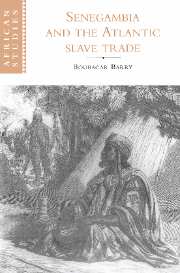Book contents
- Frontmatter
- Contents
- Preface
- Map
- I Senegambia from the fifteenth to the seventeenth century: a haven for incoming populations, a station for migrants on the move
- II Senegambia in the eighteenth century: the slave trade, ceddo regimes and Muslim revolutions
- III Senegambia in the first half of the nineteenth century: legitimate trade and sovereignty disputes
- IV Senegambia in the second half of the nineteenth century: colonial conquest and resistance movements
- Conclusion
- Notes
- Bibliography
- Index
- Other books in the series
III - Senegambia in the first half of the nineteenth century: legitimate trade and sovereignty disputes
Published online by Cambridge University Press: 31 October 2009
- Frontmatter
- Contents
- Preface
- Map
- I Senegambia from the fifteenth to the seventeenth century: a haven for incoming populations, a station for migrants on the move
- II Senegambia in the eighteenth century: the slave trade, ceddo regimes and Muslim revolutions
- III Senegambia in the first half of the nineteenth century: legitimate trade and sovereignty disputes
- IV Senegambia in the second half of the nineteenth century: colonial conquest and resistance movements
- Conclusion
- Notes
- Bibliography
- Index
- Other books in the series
Summary
The first half of the nineteenth century saw another round of major upheavals that changed all aspects of life in Senegambia. The slave trade had dominated preceding centuries. Colonial conquest would come in the second half of the nineteenth century. This was a time of transition, marked by the triumph of legitimate trade.
The 1814 Congress of Vienna signaled the resurgence of British and French power in Senegambia after a long eclipse due to the Imperial Wars. This resurgence coincided with a gradual transition from commercial mercantilism to industrial capitalism. The shift enabled Europe to impose new forms of domination over the pre-capitalist economies of the African periphery. From the start, Britain, committed to the new doctrine of free trade because it was the leading industrial nation, abolished the slave trade once it lost its usefulness as an instrument for primitive capital accumulation. Senegambia, after three centuries of uninterrupted slave trading, acquired a new function: to devote itself exclusively to the supply of raw materials and agricultural produce to Europe, and to use the proceeds for buying the manufactured products of the European industrial system, then in a state of full-scale expansion.
- Type
- Chapter
- Information
- Senegambia and the Atlantic Slave Trade , pp. 127 - 132Publisher: Cambridge University PressPrint publication year: 1997

